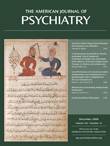Predictors of Marijuana Use in Adolescents Before and After Licit Drug Use: Examination of the Gateway Hypothesis
Abstract
Objective: The authors investigated whether the transition from licit drug use to marijuana use is determined by particular risk factors, as specified by the gateway hypothesis. They also evaluated the accuracy of the “gateway sequence” (illicit drug use following licit drugs) for predicting a diagnosis of substance use disorder. Method: Boys who consumed licit drugs only (N=99), boys who consumed licit drugs and then transitioned to marijuana use (gateway sequence) (N=97), and boys who used marijuana before using licit substances (alternative sequence) (N=28) were prospectively studied from ages 10–12 years through 22 years to determine whether specific factors were associated with each drug use pattern. The groups were compared on 35 variables measuring psychological, family, peer, school, and neighborhood characteristics. In addition, the utility of the gateway and alternative sequences in predicting substance use disorder was compared to assess their clinical informativeness. Results: Twenty-eight (22.4%) of the participants who used marijuana did not exhibit the gateway sequence, thereby demonstrating that this pattern is not invariant in drug-using youths. Among youths who did exhibit the gateway pattern, only delinquency was more strongly related to marijuana use than licit drug use. Specific risk factors associated with transition from licit to illicit drugs were not revealed. The alternative sequence had the same accuracy for predicting substance use disorder as the gateway sequence. Conclusions: Proneness to deviancy and drug availability in the neighborhood promote marijuana use. These findings support the common liability model of substance use behavior and substance use disorder.



